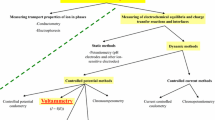Summary
Calibration of ion-sensitive electrodes using nonlinear regression analysis is combined with an increase of the working range to lower concentrations. It is possible to have statistically reliable results lower than the so-called limit of determination according to IUPAC. From these items the critical level, the limit of detection and the limit of determination are derived by the calibration function, its inverse (the function of analysis) and the confidence interval. The limit of detection is defined by the smallest detectable signal and the calibration function. The limit of determination is defined by the smallest concentration of an analysis that will be statistically significant with a preset probability of error differentiated from the concentration zero and the blind value of the potentiometric measurement. The limit of determination is therefore the smallest concentration of analysis that may be quantitatively determined.
Similar content being viewed by others
Literatur
Becht U (1985) Dissertation Würzburg
Becht U, Ebel S, Reyer B (1984) Fresenius Z Anal Chem 319:371–375
Camman K (1973) Das Arbeiten mit ionensensitiven Elektroden. Springer, Berlin Heidelberg New York
DIN (1985) Norm-Entwurf 38402 Teil 43
Ebel S (1987) parat-Jahrbuch Chemielabor. VCH Verlagsgesellschaft, Weinheim
Ebel S, Becht U (1986) Fresenius Z Anal Chem 323:359–363
Ebel S, Becht U (1987) Fresenius Z Anal Chem 327:157–164
Ebel S, Kamm U (1983) Fresenius Z Anal Chem 316:382–385
Ebel S, Kamm U (1984) Fresenius Z Anal Chem 318:293–294
Efstathiou CE (1983) Anal Chim Acta 154:41–49
Funk W, Dammann V, Vonderheid C, Oehlmann G (1982) Forschungsbericht 102 05 114. Umweltbundesamt Berlin
IUPAC Recommendations for ion-selective electrodes (1976) Pure Appl Chem 48:129–132
Kaiser H (1965) Fresenius Z Anal Chem 209:1–18
Kaiser H (1966) Fresenius Z Anal Chem 216:80–93
Kamo N, Hazemoto N, Kobatake (1977) Talanta 24:111
Kamo N, Kobatake Y, Tsuda K (1980) Talanta 27:205–208
Liteanu C, Hopirtean E, Popescu C (1976) Anal Chem 48:2013–2019
Midgley D (1979) Analyst 104:248–257
Midgley D (1980) Analyst 105:1002–1005
Moody GJ, Thomas JDR (1971) Selective ion-sensitive electrodes. Warford, Merrow
Roos JB (1962) Analyst 87:832–833
Simeonov V (1984) Fresenius Z Anal Chem 319:376–378
Wilson AL (1973) Talanta 20:725–732
Author information
Authors and Affiliations
Rights and permissions
About this article
Cite this article
Ebel, S., Becht, U. Nachweis- und Bestimmungsgrenze beim direkt potentiometrischen Arbeiten mit ionensensitiven Elektroden. Z. Anal. Chem. 329, 7–11 (1987). https://doi.org/10.1007/BF00487532
Received:
Issue Date:
DOI: https://doi.org/10.1007/BF00487532




